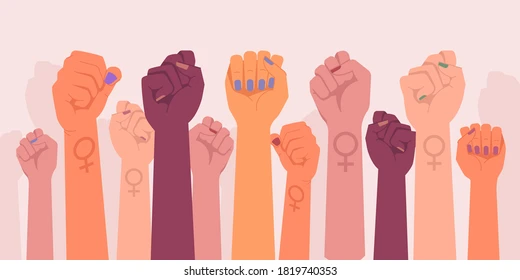As we progress through the twenty-first century, the landscape of feminism remains dynamic and multifaceted. Third-wave feminism, which emerged in the mid-1990s, is critical in addressing the complex tapestry of modern inequality. It seeks to encapsulate the experiences of women across diverse backgrounds, incorporating intersectionality, personal narratives, and the implications of digital activism. Understanding why third-wave feminism is still necessary necessitates an examination of its foundational principles, its response to contemporary challenges, and the pressing social issues that have emerged in recent years.
The initial premise of third-wave feminism was to expand the dialogue beyond the primarily white, middle-class, heterosexual lens that dominated earlier feminist movements. This wave acknowledges that identity is influenced by a confluence of factors, including race, class, sexuality, and geography. By centering the disparities faced by marginalized communities, third-wave feminism endeavors to foster inclusivity within the feminist discourse. This fundamental shift is crucial as it cultivates a more comprehensive understanding of societal inequalities faced by women today.
Intersectionality, a term coined by Kimberlé Crenshaw, captures the essence of third-wave feminist thought. It posits that individuals with overlapping identities experience unique forms of discrimination that cannot be understood solely through the lens of gender. For example, a Black woman may navigate different societal barriers than her white counterparts due to the combined impact of racial and gender discrimination. Thus, the third wave not only seeks to elevate the voices of diverse women but also aims to dismantle the systemic structures that uphold such oppressive paradigms.
The digital revolution has further entrenched the urgency for the third wave movement, as online platforms have transformed modes of communication and activism. While the tools of the internet present new opportunities for dialogue and organizing, they also bring forth challenges such as cyberbullying, misinformation, and the commodification of feminism. The volatile intersection of feminism with social media gives rise to a new kind of activism that is fluid, decentralized, and often contentious. Movements like #MeToo and #TimesUp exemplify how digital spaces can galvanize collective action and shine a light on pervasive issues like sexual harassment and assault, thus reaffirming the relevance of third-wave feminism in contemporary social landscapes.
One major area that underscores the necessity for continued discourse within third-wave feminism is economic inequality. The gender pay gap, while having decreased since the 1980s, persists stubbornly across nearly all sectors. Women earn on average 82 cents for every dollar earned by men, with women of color facing even wider disparities. This economic disparity is compounded by the fact that women are more likely to work in lower-paying, part-time positions and are often burdened with the majority of unpaid caregiving responsibilities. Acknowledging these economic inequalities enables third-wave feminists to advocate for policy reform that addresses pay equity and supports flexible working conditions.
Yet, economic issues intertwine intricately with healthcare access, reproductive rights, and bodily autonomy. The third wave emphasizes the need for comprehensive healthcare that recognizes the distinct needs of women. For instance, reproductive justice, championed by a coalition of women of color, extends beyond the right to abortion to encompass holistic access to healthcare, including prenatal care, contraception, and maternal health. The ongoing struggle against restrictive reproductive policies illustrates the importance of maintaining a feminist perspective in healthcare discourse—not merely as a matter of rights but as a crucial public health consideration with far-reaching implications.
As the global dialogue shifts toward trans rights and recognition, the significance of third-wave feminism extends into the realm of gender identity and fluidity. Traditional feminist narratives have often marginalized transgender voices, inadvertently perpetuating gender binary constructs. A more inclusive third-wave feminism challenges not only the systemic inequalities that women face but also the normative frameworks that define gender. It promotes a multidimensional understanding of gender identity and experiences, fostering solidarity across gender lines to combat broader societal injustices.
Furthermore, third-wave feminism tackles the pervasive issue of misogyny prevalent in various domains, from politics to entertainment. The insidious nature of sexism often manifests through cultural tropes that objectify women or trivialize their contributions. Events such as the backlash against prominent women in the media spotlight the need for a cultural critique that dismantles these derogatory narratives. By countering these pervasive ideologies, third-wave feminists endeavor to illuminate and challenge societal norms that diminish the value of women’s voices and experiences, advocating for a more equitable representation in all spheres of life.
Environmental justice also demands a vital role within the framework of third-wave feminism. Climate change disproportionately affects disadvantaged communities, particularly women who often bear the brunt of environmental degradation. Feminist environmentalism questions the patriarchal underpinnings of ecological policies, advocating for transformational approaches that prioritize equity and sustainability. By linking feminism to ecological consciousness, this wave of feminism emerges not only as a force for gender equity but as a catalyst for a more just and sustainable future.
Moreover, with the increasing presence of globalization and capitalism, third-wave feminism is confronted with the stark realities of labor exploitation—especially in the fashion, agricultural, and service industries where women, often from marginalized backgrounds, find themselves ensnared in cycles of poverty and mistreatment. The movement calls for ethical labor practices and encourages consumers to be conscious of their choices, thereby recognizing the intertwined fates of women and the global economy. Recognizing these connections enables a more nuanced understanding of power relations and accountability in today’s interconnected world.
To summarize, third-wave feminism remains a crucial and necessary vehicle for addressing contemporary issues of inequality. Its emphasis on intersectionality, digital activism, and advocacy against misogyny exemplifies an ever-evolving movement that adapts to the changing societal landscape. By advocating for economic justice, healthcare access, inclusivity, and environmental consciousness, third-wave feminists strive to build a framework that encompasses the diverse experiences of all women while encouraging a more equitable society for everyone. As we navigate the complexities of modern life, the third wave’s vigor and vision are essential in crafting a future that prioritizes justice and equality for all.





























